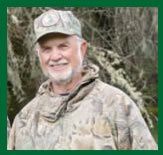Wild Pig Hunting
by Terry Knight
Unlike the state’s deer herd that is struggling to hold its own,
the wild pig population is thriving.  Certain areas of the state are
literally awash with wild pigs and in some areas they are even
considered a nuisance.
Certain areas of the state are
literally awash with wild pigs and in some areas they are even
considered a nuisance.
Locating wild pigs on a ranch can be as challenging as actually hunting them. Unlike deer that can often be seen by just driving the ranch roads, it’s rare to see a wild pig. Mostly because they’re nocturnal.
On any given piece of property only a small portion will be holding pigs. They tend to travel in groups and can cover a lot of territory. What hunters should look for are the signs that pigs leave. It will tell you if pigs have recently been in the area.
The most obvious sign of pig presence is rooting. Pigs like to root and they will tear up an area. Rooting often resembles an area that has been rototilled. Normally, the rooting will be on the hillsides and under trees. Pigs root because they are seeking weed, grass tubers and buried acorns and seeds.
It’s easy to tell if a rooting is old or fresh. New rootings will have fresh dirt and torn up grass. Most of the rooting takes place at night or early morning. If you find fresh rooting, there is a good chance that pigs are nearby.
Tracks are another good indicator of pigs. The only problem is that many hunters confuse deer tracks with pig tracks. Pig tracks are more rounded than deer tracks and they tend to be blunt on the tips.
Understanding pig behavior is another asset in becoming a successful pig hunter. Pigs normally feed at night and hole up during the daytime. The exception is when cold or bad weather hits. During cold spells, pigs need to eat more to retain body heat. Hence, they will be out feeding during the daylight hours. Under most conditions the best times to hunt pigs are the first hour after daylight and the last hour before dark. More pigs are killed in the evening hours than at any other time. Wild pigs have notoriously bad eyesight. However, they have an excellent sense of smell. Bow hunters will use the poor eyesight to sneak within shooting range. Rifle hunters can do the same. The trick is to always approach a pig with the breeze blowing into your face.
Once spooked, pigs will run for up to a mile before stopping. They have no curiosity like deer. Once they pick up your scent, they rarely stay around.
The standard deer rifle works fine for pig hunting. Most experienced pig hunters wait for a standing shot because a running pig is low to the ground and there is a good chance of either missing the pig or only wounding it. Like when hunting deer, the best shot placement is behind the front shoulder. Once the pig is down the hard work begins. Because a pig retains body heat, the animal should be immediately field dressed to cool it down. Gutting a pig is similar to gutting a deer. Make a cut lengthwise from the rear to the rib cage. Roll out the innards, being careful not to puncture the stomach.
Once you’re back at camp, skin the animal immediately. There are two methods of skinning a pig. One is to skin it like you do a deer and the other is to cut long, four-inch wide strips lengthwise through the hide. Grab the end of the strip with a pair of pliers and pull. I find this is the best method. Be sure to remove all the hair and hide from the pig as a butcher won’t take an animal that has any hair on it. Once skinned, allow the carcass to cool.
Prior to going pig hunting be sure and have a butcher shop that has agreed to take your pig. Because of recent state health laws, many butcher shops no longer process wild game. The last thing you want to do is arrive home with a 150-pound pig and nowhere to take it.
Wild pigs are excellent eating. The average 120-pound pig will yield about 50 pounds of cut and wrapped meat.
